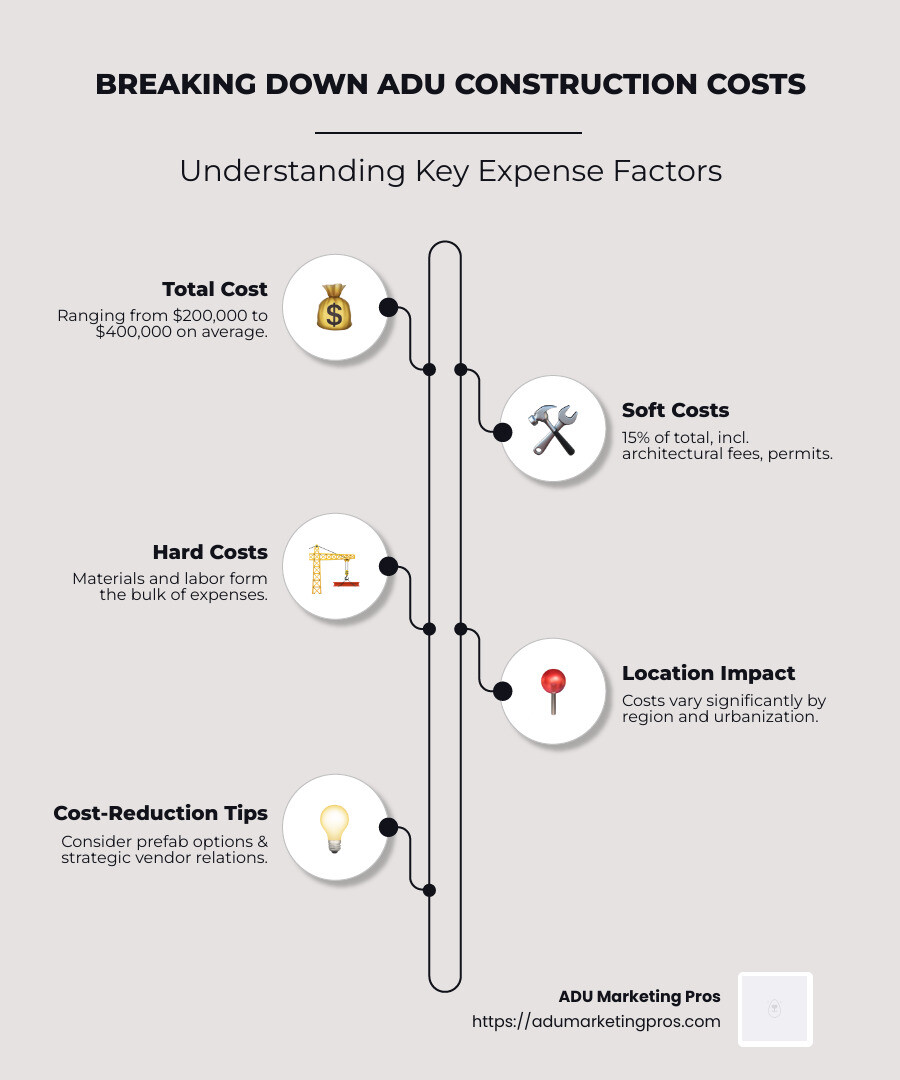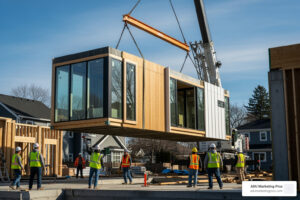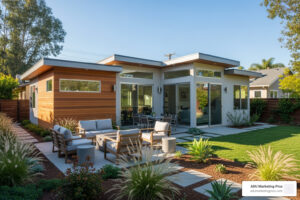ADU construction cost is a critical factor for anyone considering building an Accessory Dwelling Unit in California. If you’re curious, here’s a quick snapshot of the expenses you’re likely to encounter:
- Average Total Cost: $200,000 to $400,000
- Soft Costs (architectural fees, permits, etc.): Typically 15% of the total
- Hard Costs (materials, labor, etc.): The larger portion of expenses
With the increasing need for versatile living spaces, the popularity of ADUs is surging, especially in urban California areas. ADUs offer practical solutions for homeowners seeking rental income or additional family space without the burden of purchasing expansive new properties. As regulations make it easier to build these units, the interest in ADUs as a viable housing option is progressively growing.
Southern California has seen a marked rise in ADU permits, showcasing how keen homeowners are on utilizing their properties more effectively. This trend aligns with California’s housing policies aiming to address the state’s housing shortage and promote flexible living arrangements. By keeping construction costs clear and manageable, you can make confident decisions and perhaps even find ways to bring down expenses without sacrificing quality.
For a structured overview, here’s an infographic detailing the main components of ADU construction cost:

Understanding ADU Construction Costs
When diving into ADU construction costs, understand the various components that contribute to the overall expenses. These costs are generally categorized into soft costs and hard costs.
Soft Costs in ADU Construction
Soft costs are the expenses that don’t directly involve physical building materials or labor. They include:
-
Architectural Fees: Hiring an architect is crucial for designing an ADU that meets your needs and complies with local regulations. Expect to pay for their expertise in creating floor plans and ensuring structural safety.
-
Consultation Costs: Before breaking ground, you’ll likely need consultations with various professionals, including engineers and planners, to evaluate your site and project viability.
-
Permit Fees: Securing the necessary permits is a must. These fees can vary widely based on your location and the scope of your ADU project. In California, permit costs typically account for a significant portion of the soft costs.

Hard Costs in ADU Construction
Hard costs are the tangible expenses related to the physical construction of the ADU. They cover:
-
Site Preparation: This involves preparing your property for construction, which may include excavation, leveling, and laying a foundation. The cost here depends on your property’s condition and any obstacles like rocks or existing structures.
-
Construction Work: This is the most substantial portion of hard costs. It includes framing, roofing, and all structural elements. The complexity and size of your ADU significantly influence these costs.
-
Utilities and Interiors: Installing electrical, plumbing, and HVAC systems is essential to make your ADU livable. Interior finishes like flooring, painting, and cabinetry also fall under this category. The quality and type of materials you choose will affect the total expense.

Understanding these cost components can help you plan your ADU project more effectively. By knowing where your money goes, you can make informed decisions to manage and potentially reduce your overall costs.
Factors Affecting ADU Construction Costs
When planning an ADU, several factors can significantly influence the overall ADU construction cost. Understanding these can help you budget more effectively and make informed decisions.
Size
The size of your ADU plays a crucial role in determining costs. Generally, larger ADUs cost more due to increased material and labor needs. For example, a 1,200 sq ft ADU in California might cost between $250,000 and $350,000, while a smaller 500 sq ft unit could range from $150,000 to $250,000. However, it’s important to note that while larger units are more expensive, the additional square footage often comes at a lower incremental cost. This means that once you cover the fixed costs like site preparation and utilities, adding extra space becomes relatively cheaper.
Location
Where you build your ADU can also impact costs. In high-cost areas like California, strict regulations and high construction costs can push the budget to the upper end. Detached ADUs in California often exceed $300,000. Conversely, in more affordable regions like Texas, costs might range from $100,000 to $200,000 for similar projects. Local regulations, labor rates, and material availability all contribute to these regional differences.
Amenities
The amenities you choose for your ADU can further influence the cost. High-end finishes and additional features like decks or custom cabinetry will increase expenses. For instance, a simple garage conversion might start at $50,000, but adding luxury features could push it to $150,000 or more. Consider what amenities are essential for your needs and where you might be able to save.
By understanding these factors—size, location, and amenities—you can better anticipate the costs associated with building an ADU. This knowledge allows you to tailor your project to fit your budget while still achieving your desired outcome.
How to Manage and Reduce ADU Construction Costs
Navigating ADU construction cost can be challenging, but there are effective strategies to help manage and reduce expenses without compromising on quality.
Cost-Effective Strategies
Plan Thoroughly: Before breaking ground, make sure you have a clear plan. This includes detailed designs and a comprehensive budget. A well-thought-out plan can help avoid unexpected costs and delays.
Prioritize Needs Over Wants: Focus on what you truly need in your ADU. While it might be tempting to include high-end finishes or extra amenities, they can quickly inflate costs. Stick to essentials that meet your goals and budget.
Choose Prefab Options: Prefabricated ADUs can offer significant savings. They typically have more predictable costs compared to site-built options. Prefab units often range from $100,000 to $350,000, depending on size and finishes.
Partnering with BFPM
BFPM (Building for Property Management) can be a valuable partner in reducing costs. They offer several advantages:
Vendor Relationships: BFPM has established connections with a range of vendors. These relationships can lead to better pricing on materials and services, helping cut down your overall costs.
Expert Guidance: Their team provides expert advice at every stage of the ADU project. With their experience, you can avoid common pitfalls and make informed decisions that align with your budget.
Comprehensive Support: From planning to completion, BFPM is involved in every step. This consistency ensures that the project stays on track and within budget.
Leveraging Vendor Relationships
Building strong relationships with vendors is key to managing costs effectively. Here’s how it helps:
Negotiated Discounts: Long-standing relationships with suppliers can lead to negotiated discounts on materials and services, directly reducing your expenses.
Reliable Quality: Working with trusted vendors ensures that you receive quality materials and services, reducing the risk of costly repairs or delays down the line.
Streamlined Processes: Established vendor relationships can lead to more efficient project timelines, as the vendors are familiar with your needs and expectations.
By implementing these strategies and leveraging the expertise of companies like BFPM, you can effectively manage and reduce your ADU construction costs. This approach not only saves money but also ensures a smoother and more successful ADU project.
Frequently Asked Questions about ADU Construction Costs
What is the average cost of building an ADU in California?
Building an ADU in California can be a significant investment. On average, ADU construction costs range from $200,000 to $400,000. This wide range is due to several factors, including location, size, and the type of ADU. For instance, costs can be higher in areas like Southern California and Los Angeles, where demand is high.
A key point to remember is that regional variations can significantly impact costs. For example, urban areas with higher labor costs and stricter zoning laws might push expenses to the upper end of the range. Conversely, in less densely populated areas, costs might be on the lower side.
How do soft and hard costs differ in ADU construction?
Understanding the difference between soft and hard costs is crucial when budgeting for an ADU.
Soft Costs: These are the expenses not directly tied to physical construction. They typically make up 10-15% of the total project cost. Examples include:
- Architectural Fees: Designing the ADU and creating blueprints can cost between $20,000 and $30,000.
- Consultation Costs: Services from structural engineers or energy consultants might add $8,000 to $12,000.
- Permit Fees: Depending on the city, these can range from $5,000 to $21,000.
Hard Costs: These are the direct costs of construction, including labor and materials. They cover:
- Site Preparation: Excavation and foundation work.
- Construction Work: Building the structure, roofing, and finishing.
- Utilities and Interiors: Plumbing, electrical work, and interior finishes.
What are the cheapest ways to build an ADU?
If you’re looking to build an ADU on a budget, consider these cost-saving tips:
Choose Prefab Options: Prefabricated ADUs can be a more affordable alternative to custom-built units. They typically offer more predictable costs, ranging from $100,000 to $350,000, based on size and finish levels.
Simplify Design: Opt for a simple design with fewer custom features. This can reduce both architectural and construction costs.
DIY Finishes: If you have the skills, consider doing some of the finishing work yourself, like painting or landscaping, to save on labor costs.
By understanding these factors and exploring cost-effective options, you can manage your ADU construction cost more efficiently and make informed decisions that align with your budget.
Conclusion
As we wrap up our guide on ADU construction costs, it’s clear that building an ADU is a significant investment with many variables. However, with the right strategies and insights, you can steer these complexities effectively.
At ADU Marketing Pros, we specialize in helping ADU construction and architecture firms attract the right clients. Our expertise lies in crafting marketing strategies that highlight your firm’s strengths, ensuring you stand out in a competitive market. By focusing on expertise rather than price, we help you connect with clients who value quality and are ready to invest in premium ADU projects.
Market Insights
The ADU market is booming, particularly in California. This growth is fueled by increasing demand for flexible living spaces and the potential for rental income. Homeowners see ADUs as a valuable addition, both financially and functionally. Our continuous market research keeps us at the forefront of these trends, allowing us to provide data-driven insights that help our clients stay ahead.
Growth Strategies
To thrive in this expanding market, it’s crucial to implement targeted marketing strategies. We leverage SEO, social media, and PPC campaigns to ensure your firm reaches the right audience. Our approach is agile, allowing us to adapt quickly to changes in regulations and consumer behaviors. This ensures that your marketing efforts are always aligned with current market dynamics.
By partnering with ADU Marketing Pros, you gain more than just a marketing service. You gain a strategic partner committed to driving measurable growth for your business. We invite you to explore our services and find how we can help your firm achieve its goals in the competitive ADU sector.
In conclusion, understanding and managing ADU construction costs is essential for success. With the right guidance and marketing strategies, you can turn challenges into opportunities and ensure your ADU projects are both financially viable and rewarding.




